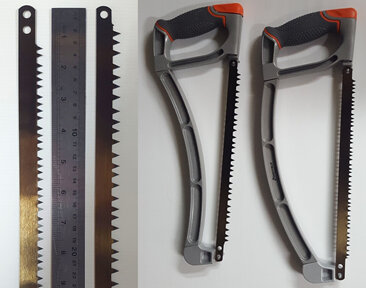Bowsaws are a versatile tool that is useful for forestry pruning tasks. Forestry pruning often involves removing branches and foliage from trees to enhance their health, shape, and growth. Here are some considerations for using bowsaws for forestry pruning:
- Blade Length and Type: Choose a bowsaw with an appropriate blade length for the size of branches you'll be pruning. Longer blades are suitable for thicker branches however, in most pruning forestry pruning situations this isn’t an issue. Shorter blades provide better manoeuvrability. Blades with aggressive teeth (i.e. large teeth), designed for cutting green wood, are preferable and also provide a faster cut.
- Teeth Configuration: Bowsaw blades come with different teeth configurations, such as raker, peg, or peg and raker patterns. Raker teeth are better for cutting green wood, while peg teeth are more suitable for dry wood. Consider the type of wood you'll be pruning and select the appropriate teeth configuration.
- Tension Adjustment: Ensure that the bowsaw has a tension adjustment mechanism. Proper blade tension is essential for efficient cutting. A tension-adjustable bowsaw allows you to maintain optimal cutting performance and extend the life of the blade.
- Ergonomic Design: Look for bowsaws with ergonomic handles that provide a comfortable grip. Forestry pruning tasks can be physically demanding, so an ergonomic design can help reduce hand fatigue during prolonged use.
- Lightweight Construction: While bowsaws need to be sturdy, a lightweight design, with narrow frame for working between branches, is beneficial for ease of use and manoeuvrability, especially when working in challenging or elevated positions.
- Replaceable Blades: Choose a bowsaw with replaceable blades. This allows you to replace a dull or damaged blade easily, extending the life of the tool and maintaining cutting efficiency.
- Safety Features: Consider bowsaws with safety features such as blade guards or locking mechanisms. These features enhance safety during transport and storage.
- Pruning Techniques: Learn and apply proper pruning techniques for forestry tasks. This includes making clean cuts just outside the branch collar to promote faster healing and reduce the risk of disease.
